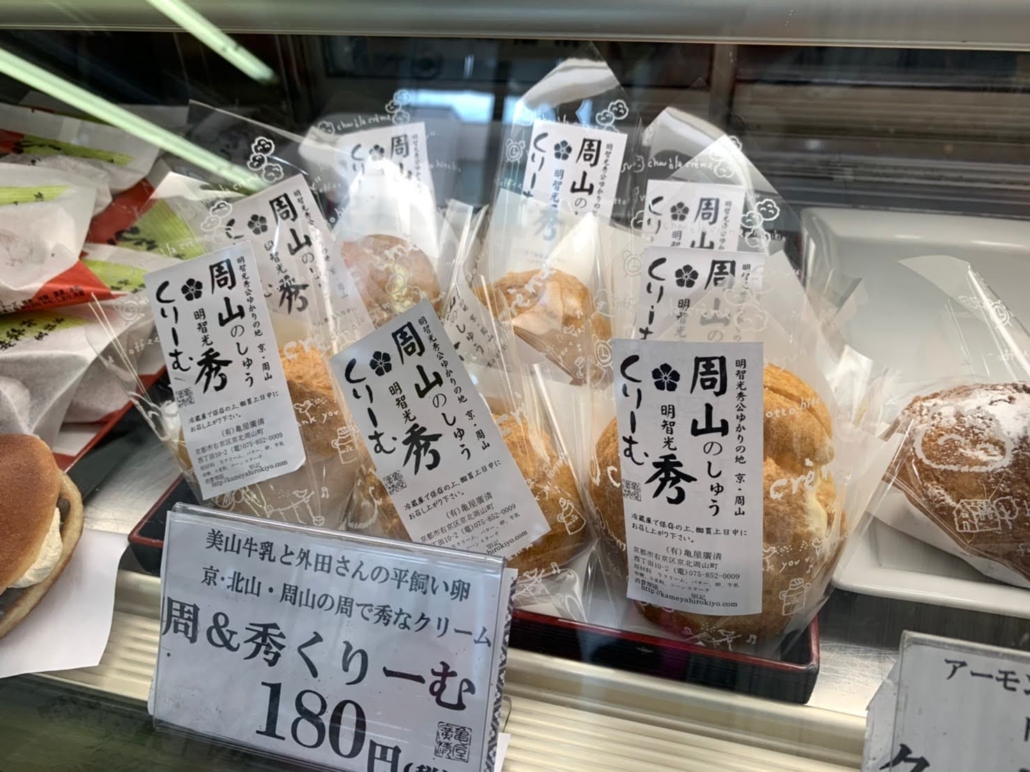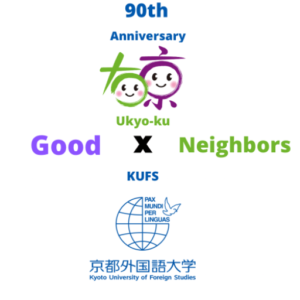[Ukyo in Action] Kameya Hirokiyo
Interviewers/Authors: Miyuki Era, Iori Yamaguchi
Mr. Yoshihiro Fujimoto (Confectioner/Pâtissier)
Kameya Hirokiyo is a confectionery shop and bakery located in Keihokushuzan-cho, Ukyo Ward, about an hour’s drive north of central Kyoto, in an area surrounded by rich nature. Since its establishment in 1922, the shop has produced and sold sweets that have continued to be loved and enjoyed by the locals. Some sweets use locally produced ingredients such as vegetables, honey, eggs, and local sake, and it is easy to feel the deep connection that exists between Kameya Hirokiyo and the region. The shop displays a variety of products that feature elements of both Japanese and Western style confectionary, including seasonal Japanese sweets, baked goods and cakes. This area is also well known as the place where Mitsuhide Akechi, a very famous samurai, was very active in the 16th century during the Sengoku period. To represent his strong ties to the area, sweets bearing the motif of Shuzan Castle and his buried treasure are sold here, as these images are directly related to this legendary warrior. In addition, in connection with Kitayama Forestry, a traditional industry in Keihoku, sweets inspired by Kitayama cedar have also become part of the shop’s signature items. In this interview, we asked the current, and third-generation owner, Yoshihiro Fujimoto, and his wife, Hiroko Fujimoto, about their work at Kameya Hirokiyo and their personal thoughts about Keihoku.
― How long have you been working for Kameya Hirokiyo?
Mr. Fujimoto: Actually, this is my parents’ house. After graduating from college, I worked at another store for about 3 years and came back here when I was 25 years old. I am 65 years old now, so I have worked in this shop for 40 years.
― What did you do before you worked here?
Mr. Fujimoto: I used to live and work in a Japanese and Western style confectionery shop after graduating from college.
― What is your main job in Kameya Hirokiyo?
Mr. Fujimoto: (pointing to cakes and sweets) This! We make cakes every day, even if we have no orders. We always have a display of them in the shop, and when they sell well we need to repeat the production process two or three times. Sometimes they don’t sell so well, so the work we do differs depending on the day. Anyway, I still continue to make something from morning to night, because I also prepare sweets with a longer shelf life, in my spare time.

― We have heard that you used to make mainly Japanese sweets in the past, so can you tell us what made you decide to produce Western style sweets, too?
Mr. Fujimoto: My parents used to only make Japanese sweets, but I guess, over time, I began to feel this was a little limiting. As I said, before I worked at Kameya Hirokiyo, I worked at a shop that made both Western and Japanese confectionery and actually, at that time, Western confectionery was selling better. That is why I made the decision to start making Western type sweets. Many Japanese confectionery jobs are really quite monotonous, but with Western confectionery there are numerous different things you need to do in a day. This often involves handling fresh ingredients, like cream, so you need to work fast to complete the process. I think perhaps this is why Western confectionary and cakes have become more mainstream.

― What particular kind of confectionery, or cake, holds special memories for you?
Mr. Fujimoto: This cheesecake is the first cake I made here. I change the mixture little by little each time, I make it though as I am still developing it. However, brandy cake is the first baked confectionery I made on my own, so that is also very special for me. The brownie like “Mokutan no Kakera (which means “a piece of charcoal”)” we sell is very popular, but the first big hit because of its unique name was the Baumkuchen “Kokishin“. The three kanji characters that make up Kokishin mean “like”, the “wood” and “heart”, and the overall meaning from the sound is “curiosity”. At first, we called it “Kitayama Sugi no Kireppashi (a small piece of Kitayama cedar)” and it sold pretty well. Anyway, I have many memories of making sweets with special or unusual names.

― Yes, when I saw the names of various sweets on the website of the shop, I realized there are many that have very unique names. How do you decide what to name them?
Mr. Fujimoto: The ideas just pop into my head! (laughs)
Mrs. Fujimoto: Actually, because we have a special attachment to the local area, we try to express the good things about the community through our sweets. For example, the confectionery called “Kigokoro“, meaning “wood and “heart” was named after those who work with trees. Since long ago, the key industry in the region has been related to forestry and lumber production, so I think that keeping up with this tradition is important. We sell sweets because we are happy if local people buy them as gifts, or if people from somewhere else want to buy some sweets related to trees. We make our products using local ingredients such as honey and sake, and in this way can let people know more about our local area through the medium of sweets. This is what we try to do as confectioners.

― What special feeling do you have about your products?
Mr. Fujimoto: I feel like I am offering the charm of Keihoku, I want to make sweets that local people can be proud of when giving to people in other areas.
― What do you do in your daily life other than making sweets?
Mr. Fujimoto: We grow our own vegetables and some of the other ingredients we use.
Mrs. Fujimoto: Of course, we do buy things from local farmers, too, but we try to use vegetables from our own garden.
― When do you feel most connected with local people? Does Kameya Hirokiyo do anything to make a connection with the community?
Mrs. Fujimoto: We have set up a donation box for the Green Fund (Midori no Bokin) and we also display books called “Keihoku no Mukashigatari“. In these books, there are stories of the legend of Mitsuhide Akechi’s buried treasure, and we make sweets related to that, too. I think displaying these books and selling themed sweets will help the local people in some way. There are also volunteer activities around here, such as guiding people to Shuzan Castle, support for people with dementia, and “Kodomo 110-ban no Ie”, which is a safe place designated by the police for children in danger. We have put up a sign at the entrance about this and it helps bring important information to the local people.
― What is your favorite thing about Ukyo Ward or Keihoku?
Mr. Fujimoto: I want to protect the natural environment around here, such as the forests, mountains and rivers. We call this area “Ukyo” now, but it used to be known as “Keihoku-cho Kitakuwada-gun, Kyoto Prefecture.”1. To be honest, it is sometimes hard to realize we are part of Ukyo-ku or Kyoto City.
― How do you like living in Keihoku?
Mr. Fujimoto: If you come from the city, you have to drive up here on mountain roads. If it rains even a little bit, the roads may be closed, so I sometimes think this is an inconvenient place to live. But I also feel quite content when I wake up in the morning. I guess it’s a little difficult to explain.
― Why do you still live in Keihoku?
Mr. Fujimoto: When I get up in the morning and take a walk around the neighborhood, I realize it’s a really nice place, and the slow pace of life suits me well. This is where I was born and raised, so I can honestly say that I am at home here.
Note:
1. Keihoku-cho, Kitakuwada County, Kyoto Prefecture, was integrated into Kyoto City on April 1, 2005, and thereafter became a part of Ukyo Ward, Kyoto City.



